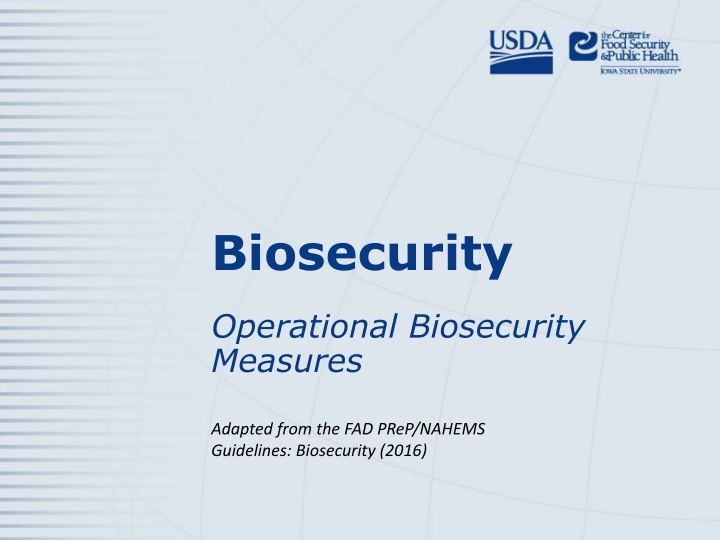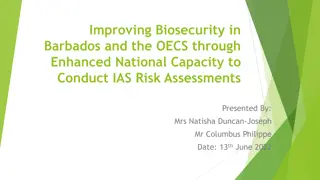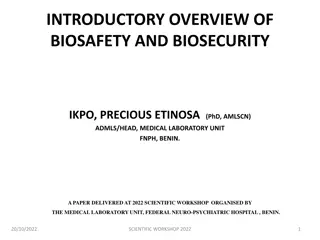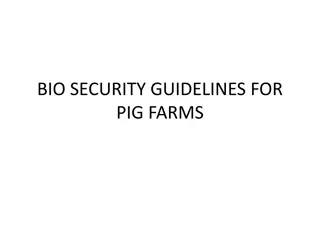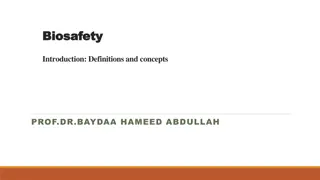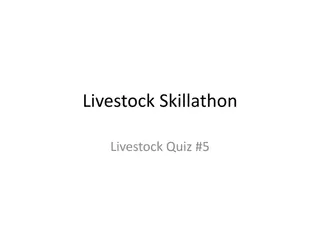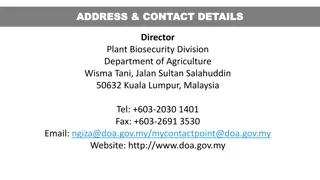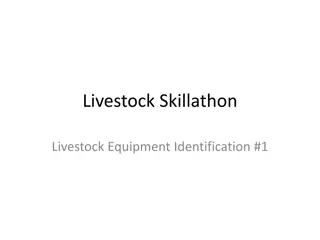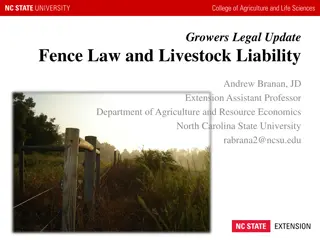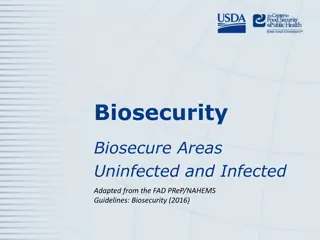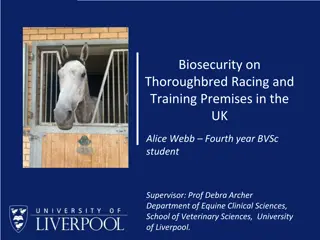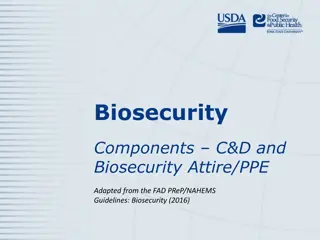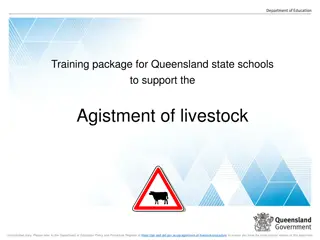Enhancing Biosecurity Measures for Livestock Operations
This presentation explores operational biosecurity measures adapted from FAD PReP/NAHEMS Guidelines, emphasizing the importance of developing an effective biosecurity plan to prevent disease spread. It discusses the three levels of biosecurity, operational processes, and procedures for personnel, vectors, animals, equipment, and more. Key aspects covered include scope of procedures, separate clean and dirty areas, and critical access points for controlling infection risk.
Download Presentation

Please find below an Image/Link to download the presentation.
The content on the website is provided AS IS for your information and personal use only. It may not be sold, licensed, or shared on other websites without obtaining consent from the author.If you encounter any issues during the download, it is possible that the publisher has removed the file from their server.
You are allowed to download the files provided on this website for personal or commercial use, subject to the condition that they are used lawfully. All files are the property of their respective owners.
The content on the website is provided AS IS for your information and personal use only. It may not be sold, licensed, or shared on other websites without obtaining consent from the author.
E N D
Presentation Transcript
Biosecurity Operational Biosecurity Measures Adapted from the FAD PReP/NAHEMS Guidelines: Biosecurity (2016)
This Presentation Describes operational biosecurity Presents considerations to develop an effective biosecurity plan Provides examples of operational measures Applicable regardless of livestock species Choices based on risk assessment Site and situation specific FAD PReP/NAHEMS Guidelines: Biosecurity - OpMeasures USDA APHIS and CFSPH
Levels of Biosecurity Operational biosecurity One of three levels of biosecurity Review of three levels of biosecurity Conceptual biosecurity Structural biosecurity Operational biosecurity FAD PReP/NAHEMS Guidelines: Biosecurity - OpMeasures USDA APHIS and CFSPH
Operational Biosecurity Processes, protocols, management practices, and standard operating procedures Keeps disease agents out Contains, prevents disease spread Measures conducted on-premises Addresses personnel, vectors, animals, equipment, and other materials FAD PReP/NAHEMS Guidelines: Biosecurity - OpMeasures USDA APHIS and CFSPH
Operational Procedures FAD PReP/NAHEMS Guidelines: Biosecurity - OpMeasures USDA APHIS and CFSPH
Scope of Procedures Movements of personnel Vectors Equipment and vehicles Carcass disposal Manure/litter management Animals Feed, replacement bedding/litter, and water supply Maintenance and security of the facility FAD PReP/NAHEMS Guidelines: Biosecurity - OpMeasures USDA APHIS and CFSPH
Separate Clean and Dirty Identify levels imagined or physical Clean areas (non-infected, protected) Dirty areas (potential source of infection) Line of Separation, C&D Line, Perimeter Buffer Area Marked on map and by physical cues Implemented at farm or barn level Critical control/controlled access point FAD PReP/NAHEMS Guidelines: Biosecurity - OpMeasures USDA APHIS and CFSPH
Critical Control Points Evaluation to determine procedures Critical control points Apply control (to prevent harm) At entrances and/or exits to premises, facility, or barn unit Apply strategic measures C&D, movement controls, and employment restrictions FAD PReP/NAHEMS Guidelines: Biosecurity - OpMeasures USDA APHIS and CFSPH
People Assigned responsible individual Develop written site-specific plan Implement and train others Prevent transfer of disease on clothes and personal articles Biosecurity attire, shower in/shower out FAD PReP/NAHEMS Guidelines: Biosecurity - OpMeasures USDA APHIS and CFSPH
Danish Entry System An example of Line of Separation FAD PReP/NAHEMS Guidelines: Biosecurity - OpMeasures USDA APHIS and CFSPH
People On-site shuttle for movements Employment conditions that minimize outside animal contact Signage as biosecurity reminders FAD PReP/NAHEMS Guidelines: Biosecurity - OpMeasures USDA APHIS and CFSPH
Vectors Wildlife, insects, and household pets Clean spilled feed immediately Structural controls to prevent entry Follow up with control programs Reduce wildlife habitat by mowing FAD PReP/NAHEMS Guidelines: Biosecurity - OpMeasures USDA APHIS and CFSPH
Equipment Dedicated equipment - avoid sharing Cleaning protocols Between groups on the premises Prior to crossing Line of Separation Supply and delivery entrance protocols to eliminate contamination FAD PReP/NAHEMS Guidelines: Biosecurity - OpMeasures USDA APHIS and CFSPH
Vehicles Internal vehicles service the facility External vehicles excluded Thorough C&D for those that must enter protected area Wheels and wheel wells Animal cargo areas and between loads Deliveries at a distant location Avoid crossing work paths FAD PReP/NAHEMS Guidelines: Biosecurity - OpMeasures USDA APHIS and CFSPH
Carcass Disposal Processes that prevent cross-contamination Off-site carcasses, feed delivery Other work paths Prevents attraction of wildlife/vectors Storage, composting, pick up at a distance from live animals Rendering trucks do not enter protected space or Perimeter Buffer Area FAD PReP/NAHEMS Guidelines: Biosecurity - OpMeasures USDA APHIS and CFSPH
Manure/Litter Management Removal process prevents exposure to live animals Management and handling avoids cross-contamination of feed delivery and work pathways FAD PReP/NAHEMS Guidelines: Biosecurity - OpMeasures USDA APHIS and CFSPH
Animals Quarantined animals/herds usually do not move off the premises Maintain as a closed herd Replacements from infection-free sources Transported in cleaned carriers Isolation of new additions FAD PReP/NAHEMS Guidelines: Biosecurity - OpMeasures USDA APHIS and CFSPH
Animals contd All-in/all-out management of groups No re-entry without biosecurity measures, especially at load-out No re-entry of animals once they leave Specific order of daily care Segregation of sick animals FAD PReP/NAHEMS Guidelines: Biosecurity - OpMeasures USDA APHIS and CFSPH
Feed, Bedding, Litter, Water Supply Closed containers to prevent contamination During delivery, storage, and handling Deliveries at a distant location Shuttled by on-site equipment Spilled feed cleaned immediately Water from deep wells or treated sources FAD PReP/NAHEMS Guidelines: Biosecurity - OpMeasures USDA APHIS and CFSPH
Maintenance Reduce environmental contamination Routine regular cleaning Thorough cleaning and downtime between groups Regular maintenance of the outside environment to discourage vectors FAD PReP/NAHEMS Guidelines: Biosecurity - OpMeasures USDA APHIS and CFSPH
Security Secure animal areas Prevents breaches in biosecurity Prevents unauthorized access Prevents lack of vigilance after-hours Lock buildings when no one present No circumventing biosecurity rules FAD PReP/NAHEMS Guidelines: Biosecurity - OpMeasures USDA APHIS and CFSPH
Conclusion Examples not totally inclusive Measures go beyond just cleaning and disinfection Measures chosen based on Specific site Specific operations Structural and conceptual biosecurity FAD PReP/NAHEMS Guidelines: Biosecurity - OpMeasures USDA APHIS and CFSPH
For More Information FAD PReP/NAHEMS Guidelines & SOP: Biosecurity (2016) http://www.aphis.usda.gov/fadprep Biosecurity web-based training module: http://naherc.sws.iastate.edu/ FAD PReP/NAHEMS Guidelines: Biosecurity - OpMeasures USDA APHIS and CFSPH
Guidelines Content Authors (CFSPH) Janice P. Mogan, DVM Heather Allen, PhD, MPA Kristen Bretz, MS Reviewers (USDA) Jonathan T. Zack, DVM James A. Roth, DVM, PhD, DACVM FAD PReP/NAHEMS Guidelines: Biosecurity - OpMeasures USDA APHIS and CFSPH
Acknowledgments Development of this presentation was by the Center for Food Security and Public Health at Iowa State University through funding from the USDA APHIS Veterinary Services PPT Authors: Janice P. Mogan, DVM; Logan Kilburn Reviewer: Kristen Bretz, MS
